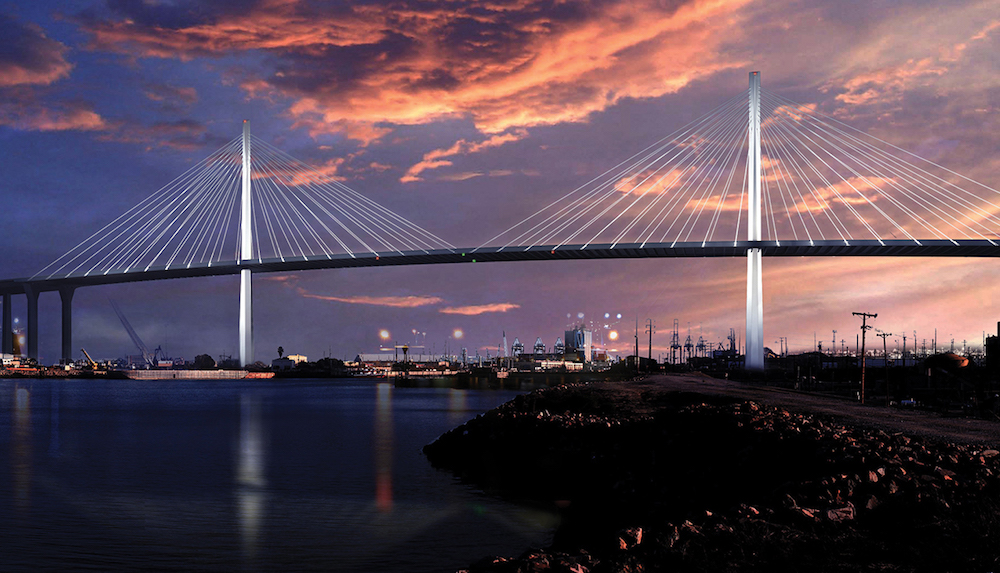It’s still faster and more cost effective to ship to most parts of the U.S. from West Coast ports than through the Panama Canal, according to a report from CBRE. The Journal of Commerce recently noted that West Coast ports have bounced back from last year’s prolonged longshoremen’s strike and have regained their customary share of containerized imports.
An expanded Panama Canal will cap cargo capacity per vessel at 13,000-14,000 TEU (a measure of container capacity), whereas western ports can already accept vessels with capacities up to 18,000 TEU, according to Dr. Noel Hacegaba, PPM, CPE, Managing Director–Commercial Operations for the Port of Long Beach, Calif.
THE PANAMAX EFFECT
Cities lining the East Coast and Gulf Coast are spending big bucks to accommodate the larger vessels that will cross a wider and deeper Panama Canal.
Last year, Long Beach handled 7.2 million containers, the third best year in its history. Hacegaba says that the Panama Canal expansion might even increase the flow of goods from east to west, especially from eastern South America. “The expansion gives suppliers alternatives,” he says.
Long Beach projects a 4% annual increase in container volume over the next several years. The port is in the midst of a $4 billion infrastructure upgrade over the next decade. Improvements include a fully automated, $1.3 billion Middle Harbor terminal capable of handling 3.3 million TEU. The port is also replacing the 50-year-old Gerald Desmond Bridge—over which 15% of the nation’s goods travel—at a cost of $1.5 billion.
Hacegaba says about 30% of containers leave Long Beach by rail. The port wants to increase rail traffic to 50% to take advantage of rail’s efficiency and environmental cleanliness compared to other transport modes. Long Beach is exploring a short-haul rail operation and an inland container yard.
Hacegaba says 18 million sf of warehouse space lies within 100 miles of the Port of Long Beach, and more is being built. “The port is an economic engine for the Inland Empire,” he says.
Related Stories
| Aug 11, 2010
PCL Construction, HITT Contracting among nation's largest commercial building contractors, according to BD+C's Giants 300 report
A ranking of the Top 50 Commercial Contractors based on Building Design+Construction's 2009 Giants 300 survey. For more Giants 300 rankings, visit http://www.BDCnetwork.com/Giants
| Aug 11, 2010
Webcor, Hunt Construction lead the way in mixed-use construction, according to BD+C's Giants 300 report
A ranking of the Top 30 Mixed-Use Contractors based on Building Design+Construction's 2009 Giants 300 survey. For more Giants 300 rankings, visit http://www.BDCnetwork.com/Giants
| Aug 11, 2010
Report: Fraud levels fall for construction industry, but companies still losing $6.4 million on average
The global construction, engineering and infrastructure industry saw a significant decline in fraud activity with companies losing an average of $6.4 million over the last three years, according to the latest edition of the Kroll Annual Global Fraud Report, released today at the Association of Corporate Counsel’s 2009 Annual Meeting in Boston. This new figure represents less than half of last year’s amount of $14.2 million.
| Aug 11, 2010
University of Florida aiming for nation’s first LEED Platinum parking garage
If all goes as planned, the University of Florida’s new $20 million Southwest Parking Garage Complex in Gainesville will soon become the first parking facility in the country to earn LEED Platinum status. Designed by the Boca Raton office of PGAL to meet criteria for the highest LEED certification category, the garage complex includes a six-level, 313,000-sf parking garage (927 spaces) and an attached, 10,000-sf, two-story transportation and parking services office building.
| Aug 11, 2010
Business park grows yet again
Construction has begun on the latest addition to Miami International Commerce Center (MICC) industrial park in Doral, Fla. The 75,000-sf facility will offer businesses 3,000 and 7,000 square feet of space. When the new building is completed, MICC will offer tenants 3.2-million sf of light industrial and flex space.
| Aug 11, 2010
Wood chips to heat school district buildings
An alternative energy plant for the Hartford Central School District in Hartford, N.Y., will be a first for the state's public school systems. Designed by Albany, N.Y.-based CSArch Architecture/Construction Management, the $1.9 million plant will provide heat and hot water to the district's elementary and high school complex, as well as to an adjacent technical school.
| Aug 11, 2010
And the world's tallest building is…
At more than 2,600 feet high, the Burj Dubai (right) can still lay claim to the title of world's tallest building—although like all other super-tall buildings, its exact height will have to be recalculated now that the Council on Tall Buildings and Urban Habitat (CTBUH) announced a change to its height criteria.
| Aug 11, 2010
Manhattan's Pier 57 to be transformed into $210 million cultural center
LOT-EK, Beyer Blinder Belle, and West 8 have been selected as the design team for Hudson River Park's $210 million Pier 57 redevelopment, headed by local developer Young Woo & Associates. The 375,000-sf vacant passenger ship terminal will be transformed into a cultural center, small business incubator, and public park, including a rooftop venue for the Tribeca Film Festival.
| Aug 11, 2010
Nation's first multistory green industrial facility opens in Brooklyn
The $25 million Perry Avenue Building at Brooklyn Navy Yard is the nation's first multilevel green industrial facility and the first building in New York to incorporate building-mounted wind turbines. The wind turbines, along with rooftop solar panels, will provide electricity for the building's lobby and common areas.







